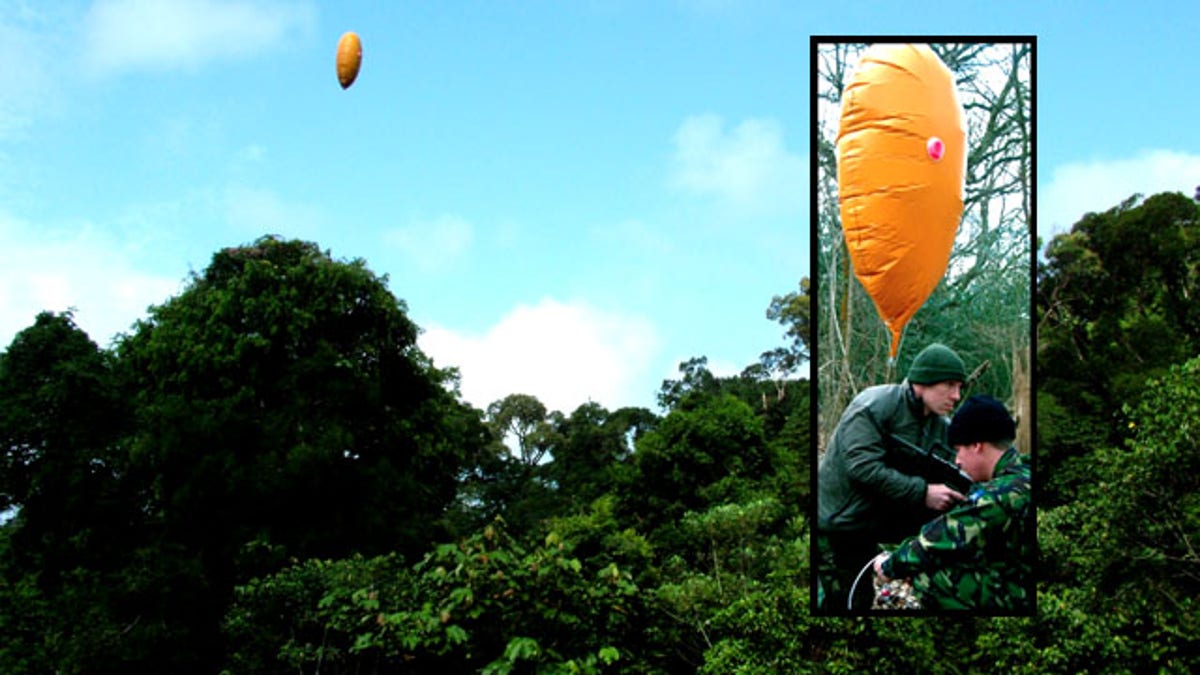
A bright orange balloon seems like the last thing a Special Forces operator would want in the jungle. Military supply company BCB argues it just might save his life. (BCB International)
Simpler is usually better.
That's why the ultimate rescue tool for elite Special Forces units deployed in jungle warfare is nothing complicated -- just a bright orange balloon.
We’ve all seen movies where people spell out S.O.S. on the ground with rocks or coconuts to signal for a rescue. That low-tech approach won't work in a jungle setting, however -- there are these things called trees. And they're everywhere.
Suppose a soldier or a downed pilot is behind enemy lines in the jungle and needs to signal for extraction undetected by enemy forces. High-tech systems as simple as a radio or as complicated as a full communication system require batteries, and batteries mean more weight, the bane of every soldier. Besides, these advanced technologies can pose risk detection -- signals can be hijacked, comms can be listened in on -- and despite extensive testing, they may still break or simply wear out in the field.
“No batteries required” is a mantra for Special Forces working in the jungle. A good old fashioned balloon, extremely lightweight and battery-free, is a great solution for jungle extraction.
Made by BCB International -- a British company that manufactures survival gear, including blast-proof boxers -- the under-$300 Air Location Marker Balloon floats above the jungle canopy so nobody below -- like the enemy a Special Forces operator may be trying to avoid -- can see it.
But helicopters sent to extract that soldier easily can.
Special Forces folks are trained for hostile environments and know how to survive in the jungle, whether they need to for a day, a week or a month. But what if someone needs immediate medical assistance?
"Carrying the balloon means knowing you can get home safely," Ben Simmons, international sales manager at BCB, told FoxNews.com. Who wouldn't want a bright orange air-location marker that can hover for days above a canopy?
The balloon is usually carried on the top of a rucksack. Packed down, it's about one and a half inches in diameter and 14 inches high. A tube from the kit connects the balloon to the compressed helium tank in a lightweight carbon fiber canister, and inflates it as big as eight soccer balls into one bright orange ball.
When full, twine in the kit can be used to release the balloon through any hole in the canopy, calibrate its precise height and then tie it off. The string will keep it at the same altitude to hover and signal for extraction.
The balloon material is sturdy, of course; poke it with a knife or needle and it'll pop like its party-balloon brethren.
After inflation, it's likely there will be some helium gas left over that could be used to have a bit of a giggle -- but as Simmons notes, that part isn’t in the instructions.
Then it's up to the pilot, and no elite pilot assigned to work with Special Forces could miss a big orange blob against a very green jungle canopy and bright blue sky. At night, there is an infrared option or the option of fastening cracked light sticks to light it to act as a beacon.
Simple in this case certainly makes sense.
If stabilization were added, the balloon would be too heavy to lift itself. If wings were included to fight against the wind, it would become heavier and complicated.
The next step for BCB will be modifying Air Location Marker Balloons to fit within the tight compartment of the Black Hawk, a choice helicopter for Asia.
No complicated fiddly bits, no risk of a signal being hijacked or the enemy listening in on communication, just a humble balloon with some twine and helium kept in a backpack.
Sometimes low-tech -- and simple -- really does make the most sense.
Ballet dancer turned defense specialist Allison Barrie has travelled around the world covering the military, terrorism, weapons advancements and life on the front line. You can reach her at wargames@foxnews.com or follow her on Twitter @Allison_Barrie.




















